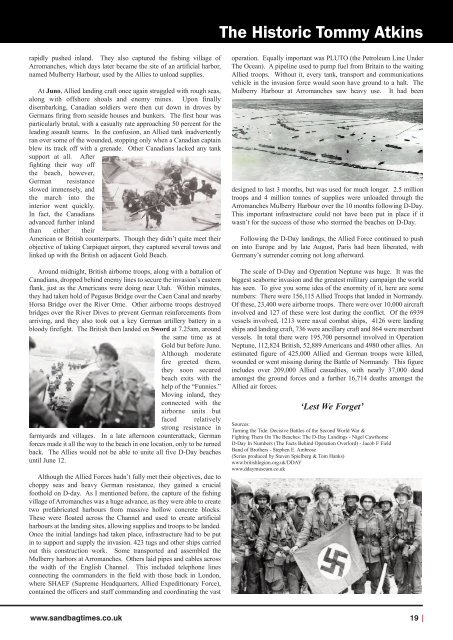The Sandbag Times Issue No: 21
The Veterans Magazine
The Veterans Magazine
Create successful ePaper yourself
Turn your PDF publications into a flip-book with our unique Google optimized e-Paper software.
<strong>The</strong> Historic Tommy Atkins<br />
rapidly pushed inland. <strong>The</strong>y also captured the fishing village of<br />
Arromanches, which days later became the site of an artificial harbor,<br />
named Mulberry Harbour, used by the Allies to unload supplies.<br />
At Juno, Allied landing craft once again struggled with rough seas,<br />
along with offshore shoals and enemy mines. Upon finally<br />
disembarking, Canadian soldiers were then cut down in droves by<br />
Germans firing from seaside houses and bunkers. <strong>The</strong> first hour was<br />
particularly brutal, with a casualty rate approaching 50 percent for the<br />
leading assault teams. In the confusion, an Allied tank inadvertently<br />
ran over some of the wounded, stopping only when a Canadian captain<br />
blew its track off with a grenade. Other Canadians lacked any tank<br />
support at all. After<br />
fighting their way off<br />
the beach, however,<br />
German resistance<br />
slowed immensely, and<br />
the march into the<br />
interior went quickly.<br />
In fact, the Canadians<br />
advanced further inland<br />
than either their<br />
American or British counterparts. Though they didn’t quite meet their<br />
objective of taking Carpiquet airport, they captured several towns and<br />
linked up with the British on adjacent Gold Beach.<br />
Around midnight, British airborne troops, along with a battalion of<br />
Canadians, dropped behind enemy lines to secure the invasion’s eastern<br />
flank, just as the Americans were doing near Utah. Within minutes,<br />
they had taken hold of Pegasus Bridge over the Caen Canal and nearby<br />
Horsa Bridge over the River Orne. Other airborne troops destroyed<br />
bridges over the River Dives to prevent German reinforcements from<br />
arriving, and they also took out a key German artillery battery in a<br />
bloody firefight. <strong>The</strong> British then landed on Sword at 7.25am, around<br />
the same time as at<br />
Gold but before Juno.<br />
Although moderate<br />
fire greeted them,<br />
they soon secured<br />
beach exits with the<br />
help of the “Funnies.”<br />
Moving inland, they<br />
connected with the<br />
airborne units but<br />
faced relatively<br />
strong resistance in<br />
farmyards and villages. In a late afternoon counterattack, German<br />
forces made it all the way to the beach in one location, only to be turned<br />
back. <strong>The</strong> Allies would not be able to unite all five D-Day beaches<br />
until June 12.<br />
Although the Allied Forces hadn’t fully met their objectives, due to<br />
choppy seas and heavy German resistance, they gained a crucial<br />
foothold on D-day. As I mentioned before, the capture of the fishing<br />
village of Arromanches was a huge advance, as they were able to create<br />
two prefabricated harbours from massive hollow concrete blocks.<br />
<strong>The</strong>se were floated across the Channel and used to create artificial<br />
harbours at the landing sites, allowing supplies and troops to be landed.<br />
Once the initial landings had taken place, infrastructure had to be put<br />
in to support and supply the invasion. 423 tugs and other ships carried<br />
out this construction work. Some transported and assembled the<br />
Mulberry harbors at Arromanches. Others laid pipes and cables across<br />
the width of the English Channel. This included telephone lines<br />
connecting the commanders in the field with those back in London,<br />
where SHAEF (Supreme Headquarters, Allied Expeditionary Force),<br />
contained the officers and staff commanding and coordinating the vast<br />
operation. Equally important was PLUTO (the Petroleum Line Under<br />
<strong>The</strong> Ocean). A pipeline used to pump fuel from Britain to the waiting<br />
Allied troops. Without it, every tank, transport and communications<br />
vehicle in the invasion force would soon have ground to a halt. <strong>The</strong><br />
Mulberry Harbour at Arromanches saw heavy use. It had been<br />
designed to last 3 months, but was used for much longer. 2.5 million<br />
troops and 4 million tonnes of supplies were unloaded through the<br />
Arromanches Mulberry Harbour over the 10 months following D-Day.<br />
This important infrastructure could not have been put in place if it<br />
wasn’t for the success of those who stormed the beaches on D-Day.<br />
Following the D-Day landings, the Allied Force continued to push<br />
on into Europe and by late August, Paris had been liberated, with<br />
Germany’s surrender coming not long afterward.<br />
<strong>The</strong> scale of D-Day and Operation Neptune was huge. It was the<br />
biggest seaborne invasion and the greatest military campaign the world<br />
has seen. To give you some idea of the enormity of it, here are some<br />
numbers: <strong>The</strong>re were 156,115 Allied Troops that landed in <strong>No</strong>rmandy.<br />
Of these, 23,400 were airborne troops. <strong>The</strong>re were over 10,000 aircraft<br />
involved and 127 of these were lost during the conflict. Of the 6939<br />
vessels involved, 1<strong>21</strong>3 were naval combat ships, 4126 were landing<br />
ships and landing craft, 736 were ancillary craft and 864 were merchant<br />
vessels. In total there were 195,700 personnel involved in Operation<br />
Neptune, 112,824 British, 52,889 Americans and 4980 other allies. An<br />
estimated figure of 425,000 Allied and German troops were killed,<br />
wounded or went missing during the Battle of <strong>No</strong>rmandy. This figure<br />
includes over 209,000 Allied casualties, with nearly 37,000 dead<br />
amongst the ground forces and a further 16,714 deaths amongst the<br />
Allied air forces.<br />
‘Lest We Forget’<br />
Sources:<br />
Turning the Tide: Decisive Battles of the Second World War &<br />
Fighting <strong>The</strong>m On <strong>The</strong> Beaches: <strong>The</strong> D-Day Landings - Nigel Cawthorne<br />
D-Day In Numbers (<strong>The</strong> Facts Behind Operation Overlord) - Jacob F Field<br />
Band of Brothers - Stephen E. Ambrose<br />
(Series produced by Steven Spielberg & Tom Hanks)<br />
www.britishlegion.org.uk/DDAY<br />
www.ddaymuseum.co.uk<br />
www.sandbagtimes.co.uk 19 |


















